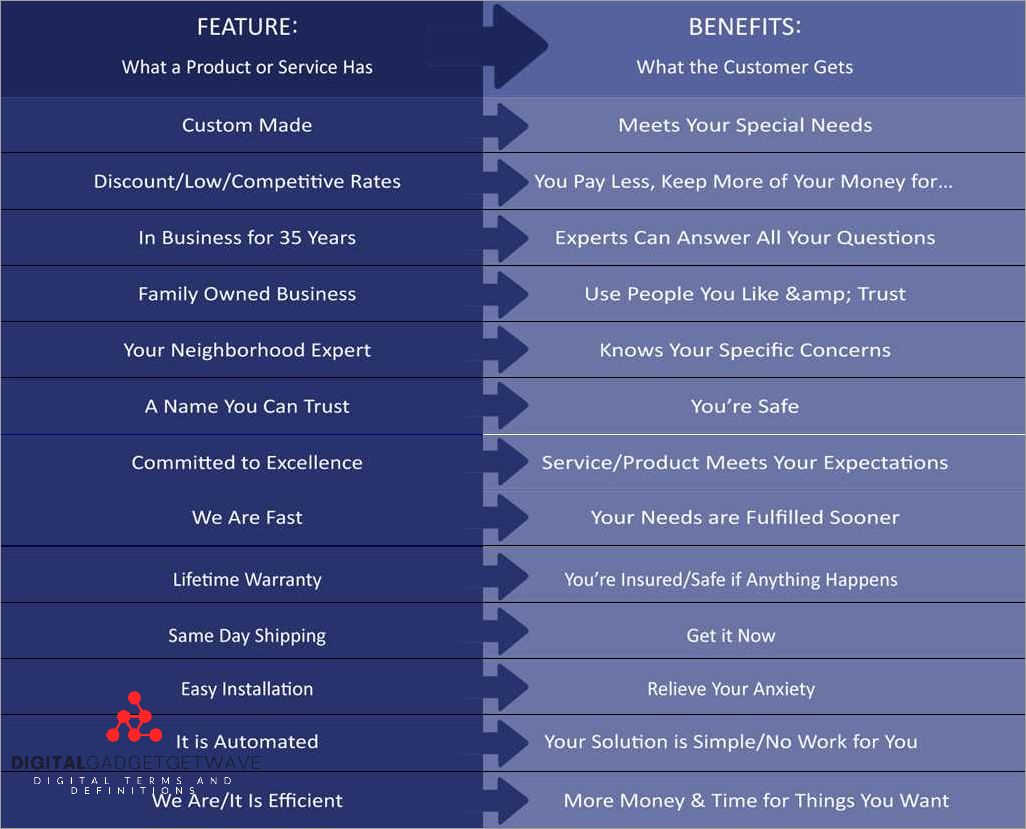![Pl-1: Benefits, Features, and Usage | [Website Name] Pl-1: Benefits, Features, and Usage | [Website Name]](/wp-content/uploads/2023/09/pl-1-benefits-features-and-usage-website-name.jpg)
PL-1, also known as Production Level 1, is a cutting-edge technology that revolutionizes the way engineers approach production and development systems. PL-1 combines advanced hardware and software capabilities to streamline manufacturing processes and enhance overall efficiency. It integrates a wide range of sensors, robotics, and simulation technologies to provide a comprehensive solution for the industry.
One of the key benefits of PL-1 is its ability to test and optimize production processes before implementation. By utilizing advanced simulation techniques, engineers can design and fine-tune the manufacturing process, reducing costs and ensuring higher quality outcomes. PL-1 also enables real-time monitoring and diagnostics, allowing for quick adjustments and improvements during production.
With PL-1, logistics become more efficient and precise. The technology provides accurate tracking and management of materials, parts, and finished products, enabling smoother supply chains and reducing the risk of delays or errors. Additionally, PL-1 offers enhanced automation capabilities, allowing for seamless integration with existing systems and workflows.
PL-1 is especially valuable in the military and defense sectors. It enables the creation of advanced prototypes and facilitates testing and evaluation of new technologies. By using PL-1, contractors can develop, refine, and validate critical systems and components, ensuring their reliability and performance in demanding environments.
Contents
- 1 Pl-1: Benefits, Features, and Usage
- 2 FAQ about topic “Pl-1: Benefits, Features, and Usage”
- 3 What is PL-1 and what are its benefits?
- 4 What are the main features of PL-1?
- 5 What are some typical use cases for PL-1?
- 6 Is PL-1 still actively used in the industry today?
- 7 Are there any alternatives to PL-1 that offer similar benefits and features?
Pl-1: Benefits, Features, and Usage
The Pl-1 is a state-of-the-art logistics simulation software designed for contractors, production facilities, and military organizations. It provides a comprehensive set of features and benefits that can greatly enhance the efficiency and effectiveness of logistics operations.
One of the key features of Pl-1 is its advanced testing and simulation capabilities. It allows engineers and logistics professionals to create virtual environments and scenarios to analyze and optimize the performance of logistics systems. This enables them to identify potential bottlenecks, inefficiencies, and risks in the supply chain and make data-driven decisions to improve overall performance.
Another major benefit of using Pl-1 is its integration with cutting-edge technology. It supports the seamless integration of various sensors, robotics, and automation systems into the logistics workflow. This enables organizations to automate repetitive tasks, increase productivity, and reduce human error.
Pl-1 also offers powerful tools for prototype development and design optimization. It allows engineers to design and test different logistics prototypes in a virtual environment, saving time and resources. This speeds up the overall development process and reduces costs associated with physical prototyping.
Furthermore, Pl-1 is specifically tailored for defense and military applications. It includes specialized modules and functionalities that address the unique requirements of defense logistics. This includes support for military-specific regulations, security protocols, and supply chain management in high-risk environments.
In conclusion, Pl-1 is a versatile and powerful logistics simulation software that offers a wide range of benefits and features for contractors, production facilities, and military organizations. Its advanced testing and simulation capabilities, integration with cutting-edge technology, and specialized modules for defense applications make it an invaluable tool for optimizing logistics operations.
Increased productivity
One of the key benefits of using the Pl-1 program is the increased productivity it provides for contractors and engineers involved in software development. Pl-1 is a high-level programming language that allows for efficient and fast assembly of code, which reduces the time and effort required for programming tasks.
With Pl-1, engineers can quickly and easily design and prototype new software and hardware systems. The language offers a wide range of features and tools that simplify the development process, such as simulation and testing capabilities. This enables engineers to identify potential issues and make improvements early on, saving time and resources in the long run.
Pl-1 also enhances productivity in the field of robotics and sensor technology. By using the language, engineers can create advanced algorithms and control systems for robotic applications. This enables faster and more accurate movement and operation, leading to increased efficiency in manufacturing, defense, and military applications.
Furthermore, Pl-1 supports multi-threading and concurrent programming, allowing for parallel processing and execution. This significantly speeds up complex computations and data processing tasks, leading to faster results and improved productivity for a wide range of industries.
In summary, the use of Pl-1 technology enhances productivity for contractors and engineers by providing efficient code assembly, simplifying design and prototyping, enabling advanced robotics and sensor applications, and supporting multi-threading and concurrent programming. These features contribute to more efficient software and hardware development, as well as improved production and operations in various industries.
Cost savings

One of the major benefits of adopting robotics technology in various industries is the cost savings it offers. By automating tasks that are traditionally performed by human engineers, companies can reduce labor costs and improve overall efficiency.
Robotic software and prototype systems can be programmed to perform a wide range of tasks, such as assembly, testing, and logistics, without the need for human intervention. This eliminates the need for hiring and training additional employees, saving both time and money.
Furthermore, robots equipped with sensors can perform complex tasks with precision, which reduces the chances of errors and the need for rework. This leads to higher quality products and fewer expenses associated with manufacturing defects.
In industries like defense and military, robotics technology can be particularly beneficial. Autonomous robots can be used for reconnaissance and surveillance, reducing the risk to human lives. In addition, robots can be employed for tasks such as bomb disposal and mine clearance, which are dangerous for human workers.
In the field of design and simulation, robotics technology can also offer cost savings. Virtual simulations can be used to test and refine product designs before they go into production, reducing the need for physical prototypes and iterations. This saves time, materials, and resources.
Overall, the adoption of robotics technology can lead to significant cost savings for companies across various industries. Whether it is in manufacturing, defense, or design, robots can streamline processes, improve efficiency, and lower expenses, making them a valuable asset for any organization.
Improved communication

Communication plays a crucial role in any industry, and the manufacturing sector is no exception. With the advancements in technology, improved communication has become a prominent benefit in modern manufacturing.
Contractors working on manufacturing projects can benefit greatly from improved communication. Through the use of advanced sensors and design software, they can effectively collaborate with engineers and incorporate changes in real-time. This leads to a more streamlined manufacturing process and ensures that the final product meets all the necessary specifications.
Improved communication also enhances the testing and simulation phase of manufacturing. The use of software development and simulation tools allows engineers to accurately test and analyze various scenarios. This helps in identifying any potential issues or defects in the manufacturing process, ensuring that the final product is of the highest quality.
In the defense and military sectors, improved communication is crucial for the development of advanced technology and systems. Engineers and logistics teams need to work closely together to design and assemble complex hardware and robotics. With enhanced communication, they can effectively coordinate their efforts, resulting in efficient production and deployment of military systems.
Furthermore, improved communication allows for better collaboration between different departments within a manufacturing company. From the design phase to the assembly line, effective communication ensures that everyone is on the same page. This results in a seamless production process, reducing the chances of errors and delays.
In conclusion, improved communication through the use of advanced technology and software has revolutionized the manufacturing industry. It has facilitated collaboration between contractors, engineers, and logistics teams, resulting in efficient production, high-quality products, and advancements in technology for various sectors including defense, robotics, and more.
User-friendly interface

The Pl-1 system provides a user-friendly interface that simplifies the development process for hardware and prototype assembly. With its intuitive design, users can easily navigate through the various features and functions of the system, making it ideal for both beginners and experienced professionals in the field of robotics and sensors.
Whether it is in the manufacturing or production process, the user-friendly interface of the Pl-1 system ensures that design and program implementation can be done effortlessly. This saves time and improves efficiency, allowing for quicker deployment of technology and better productivity for contractors and manufacturing companies.
In addition, the user-friendly interface of the Pl-1 system also offers simulation options, which are particularly useful in military and defense applications. Users can test different scenarios and analyze the effectiveness of their systems, ensuring that they are well-prepared for real-life situations.
The software’s user-friendly interface extends to logistics as well. It simplifies the process of tracking and managing inventory, making it easier for organizations to keep track of their components and materials. This improves overall efficiency in the supply chain and reduces costs associated with inventory management.
In conclusion, the user-friendly interface of the Pl-1 system is a valuable feature that enhances the overall user experience. Its simplicity and ease-of-use make it an essential tool for anyone involved in the development, manufacturing, and testing of hardware and software in various industries.
Advanced search functionality
Our website’s advanced search functionality is designed to help you find the information you need in a quick and efficient way. With the ever-growing amount of data in the defense, software, and technology industries, it is vital to have a powerful search engine that can filter through the vast amount of information available.
Whether you are looking for information on hardware development, logistics, manufacturing, or contractor systems, our advanced search allows you to narrow down your search using specific keywords. For example, if you are interested in simulation or military assembly, you can simply enter these words into the search bar and our system will generate relevant results.
Our search engine also supports Boolean operators such as AND, OR, and NOT, allowing you to refine your search even further. This means that you can search for specific combinations of words, exclude certain terms, or search for either one of several keywords.
In addition, our advanced search functionality is equipped with various filters and options to help you find the information you need. For example, you can filter your search results by date, location, or category. You can also sort the results by relevance or date, depending on your needs.
Our website is constantly updated with the latest information, so you can rely on our advanced search functionality to provide you with the most up-to-date results. Our team of dedicated engineers, production specialists, and testing experts ensures that the information available on our website is accurate and reliable.
Overall, our advanced search functionality is a valuable tool for anyone looking for information in the defense, software, and technology industries. Whether you need information on robotics, sensors, design programs, or any other topic related to these industries, our advanced search is here to help you find what you’re looking for quickly and easily.
Secure data management
In the field of sensors development and testing, secure data management is of vital importance. With the increasing reliance on sensors in various industries such as production, defense, and logistics, it is crucial to ensure the confidentiality and integrity of data collected by these sensors.
Secure data management involves the implementation of robust software and hardware systems to protect sensitive information. In the context of sensors development, this includes designing secure communication protocols and encryption algorithms to safeguard data during transmission and storage.
For example, in the production of sensor prototypes, secure data management ensures that valuable intellectual property and sensitive manufacturing information are protected from unauthorized access. This enables companies to maintain a competitive advantage and safeguard their innovations throughout the development and manufacturing process.
In the defense industry, secure data management is particularly critical. Military systems often rely on complex sensor networks that gather and analyze data for situational awareness and decision-making. Any compromise in data security can have severe consequences, compromising national security and endangering the lives of military personnel.
Furthermore, secure data management plays a vital role in the contractor manufacturing process. With the involvement of multiple parties in the design and production of complex sensor systems, it is essential to establish secure channels for data exchange and collaboration. This ensures that sensitive information remains confidential and is accessible only to authorized personnel.
In summary, secure data management is essential in the field of sensors development, testing, and production. It protects valuable intellectual property, ensures the integrity of sensitive information, and supports collaboration among engineers and manufacturers. By implementing robust security measures, companies and organizations can confidently rely on sensor technology for various applications, from military defense to logistics and beyond.
Businesses

In the field of engineering and design, businesses play a crucial role in the development of various systems and prototypes. They engage in activities such as designing and testing defense systems, manufacturing hardware and software components, and conducting simulation and engineering analysis.
Manufacturing businesses are responsible for the assembly and production of various products, ranging from consumer electronics to aerospace components. They often work as contractors for larger projects, providing specialized production capabilities and expertise.
Technology businesses are involved in the development and implementation of advanced technologies. They focus on areas such as artificial intelligence, robotics, and sensor technology. These businesses contribute to the advancement of various industries, including healthcare, automotive, and logistics.
Software development businesses specialize in creating and optimizing software solutions for a wide range of applications. They collaborate with other businesses to develop custom software for specific needs and also provide support and maintenance services.
Overall, businesses in the engineering and technology sectors play a vital role in driving innovation and progress. They bring together a diverse range of skills and expertise to develop cutting-edge solutions that enhance various aspects of our lives and industries.
Education
In the field of education, PL-1 software plays a crucial role in the development of various subjects. Whether it is in computer science, engineering, or any other technical discipline, PL-1 helps students understand and implement complex concepts related to software and hardware. With PL-1, students can design and test programs, simulate different scenarios, and gain hands-on experience in a controlled environment.
The military and defense sector also heavily relies on PL-1 in their education programs. By incorporating PL-1 into their curriculum, military personnel, defense contractors, and engineers gain a comprehensive understanding of advanced systems and technologies used in the field. They learn how to utilize PL-1 for the development, production, and assembly of prototypes, as well as for the testing and logistics of defense systems.
Moreover, PL-1 enables students and professionals in various industries to explore different aspects of technology. They can specialize in areas such as sensors, manufacturing, and system integration. By using PL-1, they are able to enhance their knowledge and skills in these specific areas, and ultimately contribute to the advancement of their respective industries.
To cater to the diverse needs of learners, PL-1 offers a range of educational resources. These include online tutorials, documentation, and code examples that provide step-by-step guidance on using PL-1 for different purposes. Additionally, PL-1 supports collaborative learning through online forums and communities, where users can exchange ideas, ask questions, and share their experiences.
In summary, incorporating PL-1 into the field of education provides students, professionals, and organizations with a powerful tool for enhancing their understanding and skills in various technical disciplines. Whether in software development, engineering, or defense systems, PL-1 plays a vital role in education by enabling hands-on learning, simulation, and the exploration of advanced technologies.
Personal use

Advancements in technology have greatly influenced the way individuals interact with various products and services, including those used for personal purposes. Today, technology has a significant impact on the production, design, and program of these products, resulting in innovative and user-friendly solutions.
Military systems and software, which were once exclusively developed for military operations, are now being adapted for personal use. For instance, simulation and robotics technologies that were initially used by military engineers are now available for personal development. This has opened up new opportunities for individuals to explore their creativity and enhance their skills in programming and robotics.
One of the benefits of personal use technology is its ability to provide a hands-on learning experience. Engineers and hobbyists can use innovative software and manufacturing techniques to create their prototypes and test different designs. This allows them to gain practical knowledge and expertise in various areas such as sensors, assembly, and hardware integration.
Contractors and logistics professionals also benefit from personal use technology. With the help of advanced software and manufacturing capabilities, they can optimize their processes and improve efficiency in areas such as production planning, inventory management, and supply chain logistics.
Personal use technology has become increasingly popular in various fields, including healthcare, education, and entertainment. For example, individuals can now access medical devices and sensors for monitoring their health conditions at home. Educational institutions and hobbyists can also use personal use technology to facilitate learning through interactive simulations and virtual reality experiences.
In conclusion, personal use technology has revolutionized the way individuals interact with products and services. With advancements in areas such as programming, simulation, and manufacturing, people now have access to powerful tools and resources for their personal development and creative endeavors.
FAQ about topic “Pl-1: Benefits, Features, and Usage”
What is PL-1 and what are its benefits?
PL-1, also known as Programming Language One, is a high-level programming language developed in the 1960s. It was designed as a successor to Fortran and COBOL, with the goal of providing a more modern and powerful language for scientific and engineering applications. The benefits of using PL-1 include its support for structured programming, its strong typing system, and its ability to handle complex data structures. Additionally, PL-1 has a rich set of built-in functions and extensive I/O capabilities, making it a versatile choice for a wide range of applications.
What are the main features of PL-1?
PL-1 has several key features that set it apart from other programming languages. Firstly, it supports block structure, allowing programmers to easily organize their code into logical units. It also has strong typing, which helps catch errors at compile time and improves program reliability. PL-1 supports both procedural and object-oriented programming paradigms, making it flexible for different coding styles. Additionally, PL-1 has built-in support for handling strings, arrays, and complex data structures, which simplifies programming tasks. Finally, PL-1 offers extensive I/O capabilities, making it easy to interact with files and input/output devices.
What are some typical use cases for PL-1?
PL-1 is commonly used in scientific and engineering applications due to its strong support for complex data structures and mathematical operations. It is also used in legacy systems, as many older mainframe computers were programmed in PL-1. Furthermore, PL-1 is often used in academic settings for teaching programming concepts and principles. Additionally, PL-1 can be used for developing business applications, as it has built-in support for handling strings and I/O operations. Overall, PL-1 is a versatile language that can be applied to a variety of programming tasks.
Is PL-1 still actively used in the industry today?
While PL-1 was popular in the 1970s and 1980s, its usage has declined over the years. Many organizations have transitioned to more modern languages like C, Java, and Python. However, there are still some legacy systems and mainframe computers in operation that rely on PL-1, so there is a niche market for programmers with PL-1 skills. Additionally, PL-1 is still used in academic settings and for teaching purposes. Overall, while PL-1 may not be as widely used as it once was, it still has its place in certain industries and educational contexts.
Are there any alternatives to PL-1 that offer similar benefits and features?
Yes, there are several programming languages that offer similar benefits and features to PL-1. For scientific and engineering applications, languages like Fortran and MATLAB provide strong support for mathematical operations and complex data structures. For business applications, languages like COBOL and RPG offer similar functionality with a focus on data processing and transaction handling. Object-oriented languages like Java and C++ also provide features for structured programming and complex data handling. Ultimately, the choice of language depends on the specific requirements and goals of the project or application.

